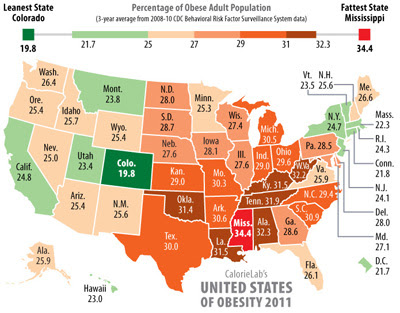Try to imagine 180,000 obese adults living in Texas. 90,000 in Michigan. And 10,000 more in West Virginia. All in all, 1 million obese American adults.
And that’s just the increase since last year. Already 27.2 percent of U.S. adults were obese, and the rate jumped up to 27.6 percent in just one year.
The obesity map (courtesy of CalorieLab) shows an obesity trend with little sign of slowing down.

You might hope that a population that was working fewer hours than before would have more time to devote to staying healthy and losing weight, but it doesn’t work that way. In general, adding more difficulties to people’s lives doesn’t make it any easier for them to solve their existing difficulties. Rather, the more problems a person has, the harder it is to solve each of the problems. This is one of the reasons why lifestyle problems tend to cluster in the same places.
Compare the state obesity map above, which is based on a Centers for Disease Control survey, to the state smoking map below, from the National Cancer Institute. Smoking rates, fortunately, are not nearly as high as obesity rates, but if you look at the states with the highest obesity rates, from West Virginia to Oklahoma, they also have some of the highest smoking rates.

Conversely, if you look at the states with the lowest obesity rates — Colorado, California, Washington, and Hawaii in the west, along with most of the northeastern states, you also find relatively low smoking rates.
Smoking is a special kind of problem because tobacco is addictive, but prescription drugs occur in nearly the same geographic distribution. This can be seen in the map below, from The Kaiser Family Foundation site statehealthfacts.org. The map shows prescriptions filled per capita by state in 2009.

States with the most prescriptions also tend to be the states with the highest rates of tobacco use and obesity. It’s no secret that some prescription drugs cause obesity, or that obesity and tobacco use cause illnesses that may be treated with drugs, but that isn’t the whole story. Lifestyle problems don’t exist in isolation. All of these rates reflect problems that are more likely to occur, and less quick to be solved, among people who already have multiple lifestyle problems. Perhaps to an extent these are problems that can be addressed in isolation, but the real solution is something more abstract. At the risk of sounding vague and fanciful, these are all problems that tend to be solved when people reach a higher level of success in life.
Looked at through this lens, the news of 1 million more obese Americans since last year is not a hopeful sign. It really represents 1 million more people who have been beaten down by the economy. It makes sense, when you look at it this way, that the largest increase in obesity is seen in Michigan, the state facing the toughest economic challenges. Finding a way to expand the economy will help, but we also need to look for ways to change the workings of the economy so that not so many people end up its victims.
